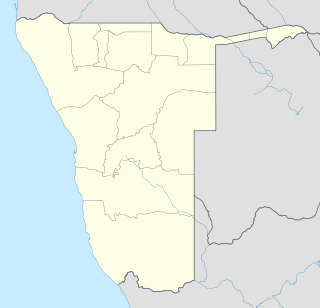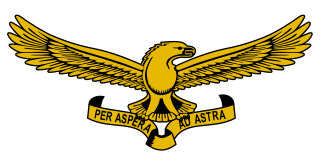
24 Squadron SAAF is a disbanded squadron of the South African Air Force. Its last role was as an attack aircraft squadron. The squadron was first formed during World War II on 5 March 1941 by renumbering 14 Squadron SAAF in Egypt. It later carried out bombing operations in Kenya and North Africa, before taking part in the Italian campaign before disbanding in late 1945 at the conclusion of hostilities. The squadron was later re-raised and operated jet aircraft in an attack role during the Border War. It was finally disbanded in early 1991.

1 Squadron SAAF was an air force squadron of the South African Air Force and was formed at Air Force Station Swartkop in February 1920, equipped with De Havilland DH.9's part of the Imperial Gift donation to South Africa by Britain. On 31 August 1939 the squadron was re-designated as 1 Bomber/Fighter Squadron and this was then changed to 11 (Bomber) Squadron in December 1939. The squadron was resurrected in February 1940 by the renumbering of 6 Squadron, equipped with four Hurricane Mk 1's and six Furies.

Operation Protea was a military operation during the South African Border War and Angolan Civil War in which South African Defence Forces (SADF) destroyed a number of South West Africa People's Organisation (SWAPO) bases in Angola. During the operation, which took place from 23 August to 4 September 1981, up to 5,000 SADF soldiers occupied Cunene province, Angola.

Operation Daisy was a military operation conducted from November 1–20, 1981 by the South African Defence Force and South West African Territorial Force (SWATF) in Angola during the South African Border War and Angolan Civil War. This conflict was sparked when the South African Defence Force decided to try to halt the regroup of the active military branch of SWAPO, also known as the People's Liberation Army of Namibia.

Operation Rekstok was a series of South African raids into southern Angola on 7 March 1979 during the South African Border War. The operation lasted six days. Operating from Ovamboland, SADF forces entered Angola and attacked SWAPO bases at Mongua, Oncocua, Henhombe and Heque. During the operation, a SAAF bomber was shot down, killing Lieutenant Wally Marais and Second Lieutenant O. J. Doyle. The SADF conducted Rekstok concurrently with Operation Safraan and later performed Operation Sceptic.

12 Squadron was a South African Air Force squadron that served in World War II in East Africa and the Western Desert as a medium bomber squadron. After the war, the squadron was used in various roles, including that of a helicopter squadron until 1963 when it was equipped with Canberra light bombers – remaining a light bomber and reconnaissance squadron until disbanded in 1990.
Denis John Earp is a former South African military commander, who held the post of Chief of the South African Air Force.
The History of the South African Air Force spans the First World War, Rand Rebellion of 1922, the Second World War, the Korean War, the South African Border War, and varied peacekeeping operations since 1994. Its battle honours include German South West Africa 1914–15, German East Africa 1915–1918, East Africa: 1939–1941, Middle East: 1941–43, Madagascar 1942, Italy 1943–1945, the Balkans 1943–1945, and Korea 1950–1953.

Operation Konyn was a military operation by the South African Defence Force during the South African Border War and Angolan Civil War. Operation Konyn was launched on 21 August 1981. The operation preceded Operation Protea with the objective of destroying targets at Cahama and Chibemba in Angola. The Angolans had built a series of radar and early warning stations at Cahama, Chibemba, Lubango and Menongue. Attacking the first two target towns would ensure that the People's Armed Forces for the Liberation of Angola (FAPLA) would not interfere with the South African Air Force operations in support of South African Defence Force (SADF) ground troops taking part Operation Protea against People's Liberation Army of Namibia bases.

Operation Klinker was a military operation in Angola during December 1983 by the South African Defence Force (SADF) and South African Air Force (SAAF) during the Angolan Civil War and South African Border War.

Operation Skerwe was a military operation conducted by the South African Air Force (SAAF) against African National Congress (ANC) facilities based in the Maputo suburb of Matola.

Operation Cerebus was a South African Defence Force (SADF) special forces operation conducted in Angola during October 1985 during the South African Border War and Angolan Civil War.

Operation Merlyn was a military operation by the South African Defence Force (SADF), South West African Territorial Force (SWATF) and South West African Police (SWAPOL) during the South African Border War and Angolan Civil War in April 1989. The aim of the operation was to prevent the incursion of PLAN (SWAPO) insurgents into South West Africa/Namibia from bases in Angola. These incursions were in violation of a ceasefire which came into effect on 1 April 1989 via the implementation of United Nations Security Council Resolution 435 and the Tripartite Accord. Initially, these PLAN incursions were tackled by South West African police units and eventually by SADF and SWATF units, released to assist the police having been confined to their bases by the peace agreements. These incursions and the conflict that occurred ended after hastily arranged talks resulted in the Mount Etjo Declaration and an eventual ceasefire.

Operation Vanity was a Rhodesian military operation in Angola with clandestine assistance from the South African Air Force (SAAF) during the Rhodesian Bush War. The Rhodesian Air Force planned a retaliatory raid against a ZIPRA camp in Angola after a second Air Rhodesia Viscount was shot down on 12 February 1979.

Operation Egret was a military operation in Angola during September 1985 by the South African Defence Force (SADF) against People's Liberation Army of Namibia (PLAN) during the Angolan Civil War and South African Border War.

Operation Magneto was a military operation in August 1985 to transport UNITA soldiers by the South African Defence Force (SADF) during the Angolan Civil War and South African Border War.

Operation Abrasion was a South African special forces military operation in December 1985 by the South African Defence Force (SADF) during the Angolan Civil War and South African Border War.

Operation Placid was a Rhodesian military operation in Zambia with clandestine assistance from the South African Air Force (SAAF) during the Rhodesian Bush War. The Rhodesian Air Force planned raids against a ZIPRA camps in Zambia on the northern Rhodesian border.

Operation Motel was a Zimbabwe Rhodesian military operation in Zambia with clandestine assistance from the South African Air Force (SAAF) during the Rhodesian Bush War. The Rhodesian Air Force planned raids against a ZIPRA camp in Northern Zambia.













